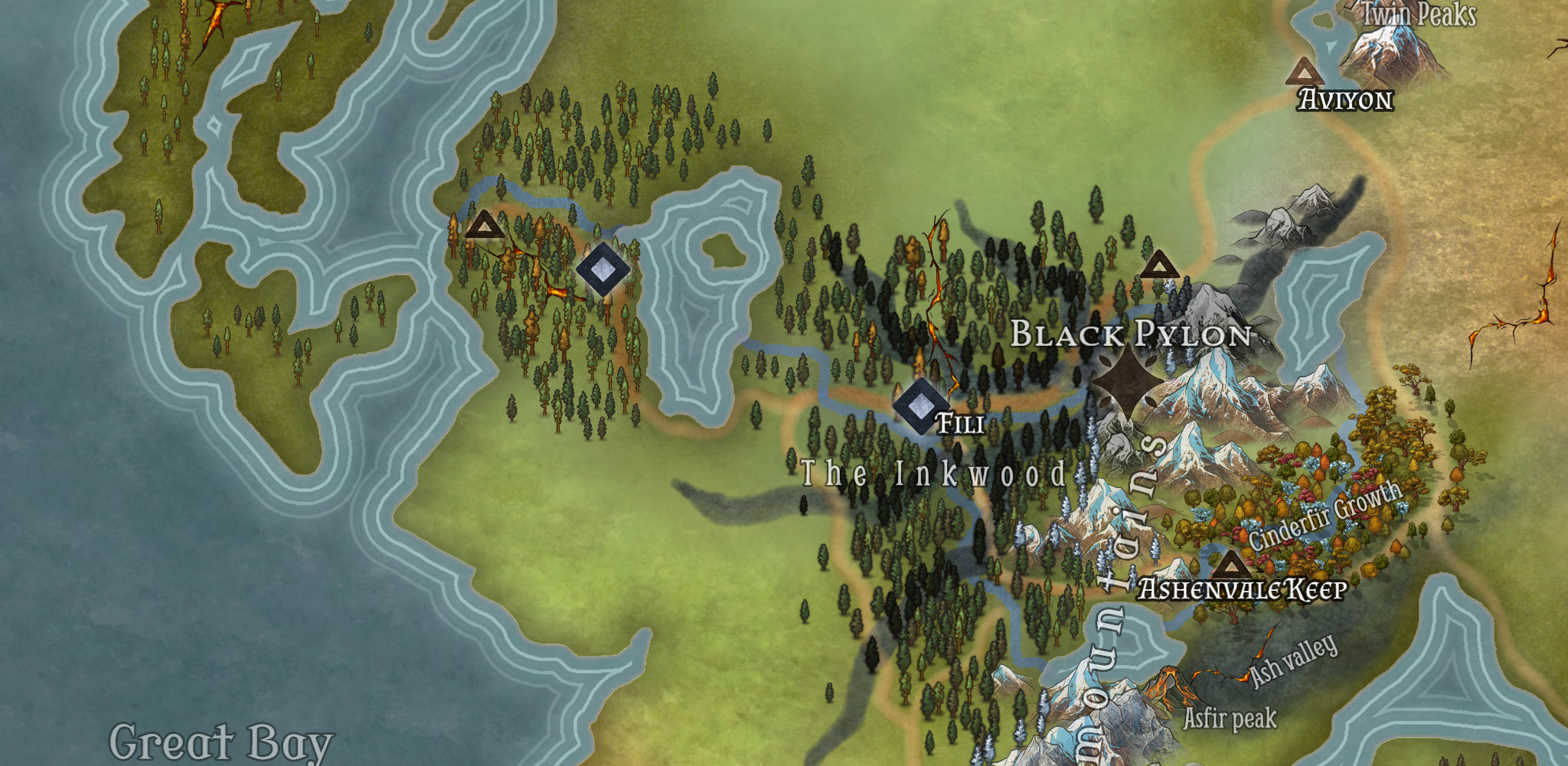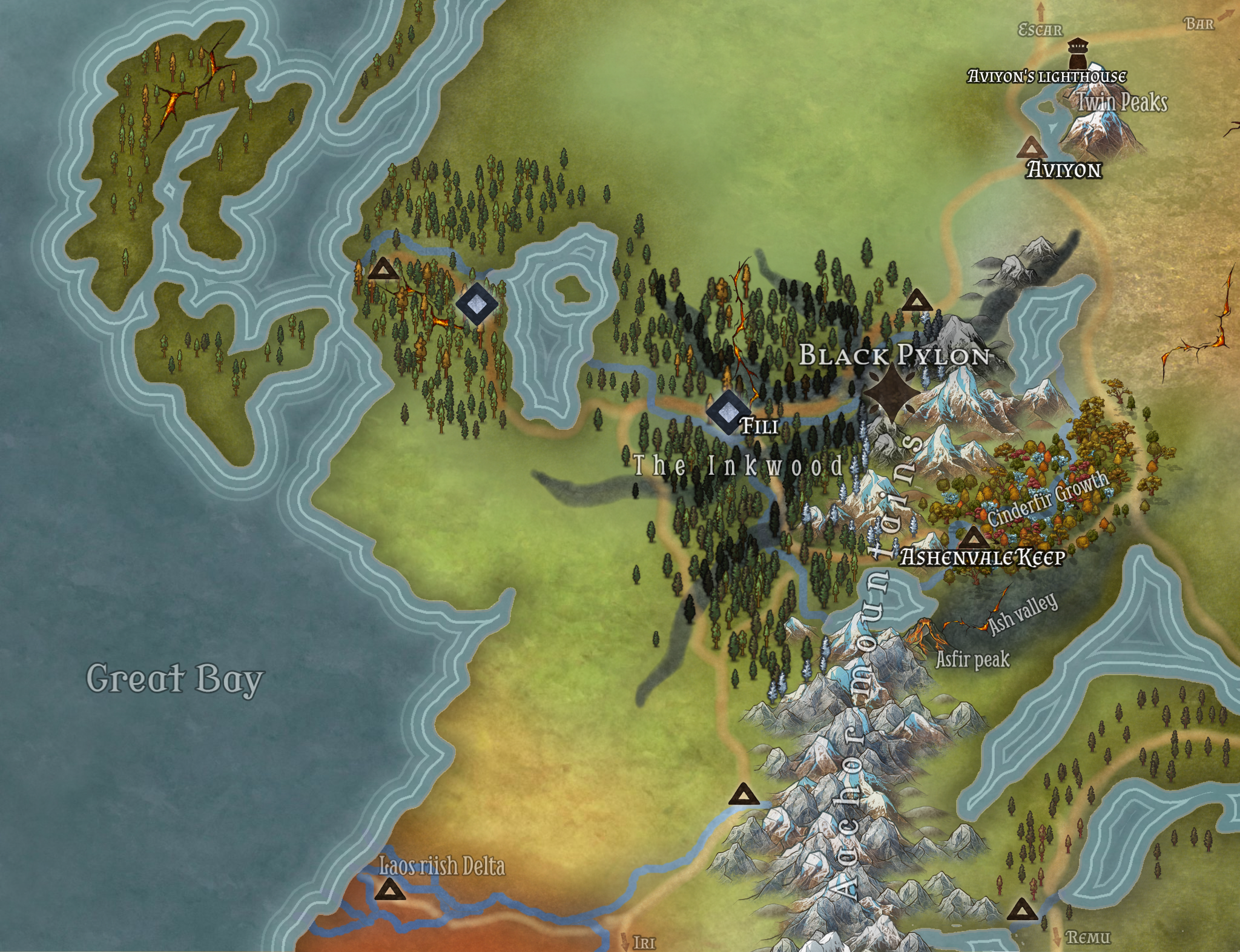The Inkwood
Here follows a handy guide for anyone who might want, or need, to travel to the Inkwood:
- First impressions
- The dangers
- The riches
- Geography and history
- My best advice
First impressions
Should one wander by chance, or purpose, into the inkwood, it won't take long to notice which forest you have entered. The forest from certain edges appears to be an ordinary, deciduous forest. You will probably encounter ordinary forest scenes like anthills, the hooting of owls or the howling of wolves and drayi. But not all is as it seems. This forest is not named the Inkwood for nothing. One has to wander only for a while before undoubtedly encountering some of its more special inhabitants. A black stroke might cut across the path. Unassuming, perhaps, but on both edges, the black stripe extends deep into the forest. These are the inky strokes of the black pylon. This magical comet seems to harden everything that comes into prolonged contact with it, including the very earth it landed on. Trees that grow on these black paths also turn black, and the bark slowly turns hard as stone, blunting any axe that dares chop it. Some animals, too, have been.. changed. The transformation is a long, slow process, and not all animals are made for this. Especially larger animals like humanoids, bison, bears and elk have not been known to survive the change. So most animals will quickly step over the black paths, but some do not get this chance, and, if they are lucky, they emerge alive and changed for good. If you spend a day or two in this forest, you'll surely encounter some of these unique creatures. Some are more dangerous, or valuable, than others. Let me tell you more about the first type.The dangers
The forest itself is no more dangerous than any other forest with large predators. But there are some things you might not be prepared for. The most obvious one is the Barkhound. These animals were once common wolves, but a few had their den right in the way of the black path. Their cubs' fur turned black and tough, appearing almost as bits of bark rather than fur. These cubs managed to grow up and propagate. While no more dangerous than a normal pack of wolves, they are much harder to kill and have grown more bold than their unchanged cousins.Many insects also change, but you'll hardly notice the difference between an ant you can or cannot squat with your foot. A spider's bite grows strong enough to pierce leather or skin, but still will not do much more than make you go 'ouch!'. Few birds have been affected, as the eggshell turns too hard to break for most chicks. Of the few that survive the change, the hardening of their feathers makes them much worse flyers, so the few black birds that survive the transformation usually leap and glide rather than fly. While generally not aggressive, they are a lot heavier, and when they mob, they can pose a real threat.
As a general rule, you can presume the black animals to behave slightly bolder and more sporadic than normal, but above all, they will be much, much harder to harm.
The riches
With only the ordinary dangers lurking in this forest, one might willfully venture into this forest for its riches. It is a thriving forest with enough fruits, roots and meat to nourish a small group of explorers. While the stonelike wood or glittering black rock can sell for a decent price due to its intricate growth patterns, it is probably not worth breaking your tools over it. The real riches come in two forms. The first are the manes of the barkhound. While most of their fur changed to a bark-like texture, their manes stayed fur-like. While beautifully flowing with a glint of purple and green when the light hits it, they stiffen when struck. Making them exceptional protection for the more flexible body parts. While maintaining a luxurious and extravagant aura. The second thing making your trip worthwhile is black silk. While spiders, for the most part, do not take well to the transformation, and usually die within a few months of changing. Their silk turns into an extremely strong yet flexible wire. And will fetch a worthy price with a skilled tailor and other craft masters.Geography and history
The Inkwood is an old forest; it was once quite cold, with a minor stream running through it. It is located on the windward side of the Southern Aachor mountains, so it receives quite a bit of rain from the south-western warmer winds of the Great Bay. There is one long, narrow lava rift running from the northern edge towards the centre of the woods. Along this ridge, trees grow taller and take on a more orange hue. This is where the Fili group of the Kádi Dwarves first settled. From whom the forest and the settlement took their name of Filinor Forest. Filinor was the first settlement of the dwarves that saw some actual warm summers (The Bar and Escar settlements are too far north). The Fili settled where the lava rift met the merging of two rivers. They used the water of the stream and the heat of the lava rift to meet their living needs. They hunted and scavenged the forest for food, and fished the river. During the The Silver Rain, the black pylon crashed in the foothills of the forest. At first, the consequences seemed to be minimal, but after a while, the pylon appeared to send out tendrils of sorts that slowly blackened the forest. Changing all materials that didn't move out of its path. While these paths expand imperceptibly slow, falling asleep too close to it could wake you up to a.. surprising and painful morning.The black trees are revered as unmoving sentinels of the forest, but their leaves have become a bit of a problem. Every year during the month of Stormsurge, they drop their leaves. While useful for roof shingles, there are only so many roofs that need new shingles. The critters and fungi of the forest have not found a way to decompose them yet. So the black paths are covered in a thick layer of black leaves. Sharp as shards of obsidian.






I love this. I bet it is very dramatic to look at, though I would be wary about exploring it.
Explore Etrea | WorldEmber 2025
Thanks! :D I think it looks scarier than it really is. I wanted a 'dark forest' to nót be the big bad for once :p